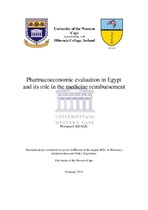| dc.contributor.advisor | Bapoo, Rafik | |
| dc.contributor.author | Mohamed Khalil | |
| dc.date.accessioned | 2018-09-06T08:48:24Z | |
| dc.date.available | 2018-12-31T22:10:06Z | |
| dc.date.issued | 2018 | |
| dc.identifier.uri | http://hdl.handle.net/11394/6385 | |
| dc.description | Magister Scientiae - MSc (Pharmacy Administration and Policy Regulation) | |
| dc.description.abstract | Aim: The purpose of this research was to assess the validity of pharmacoeconomic
evaluation in Egypt three years after the guideline was issued and analyse challenges
and opportunities for improvement.
Objectives: To conduct a literature review of pricing, medicine reimbursement, and
pharmacoeconomic evaluation. Examine, in conjunction with relevant stakeholders, the
progress of the pharmacoeconomic evaluation. To present examples of
pharmacoeconomic evaluation deployment. To propose recommendations on how to
optimize the pharmacoeconomic implementation.
Methods: A literature review and a qualitative research method that was conducted
using a semi-structured interview with stakeholders of the reimbursement process in
Egypt. In addition, examples were analysed to determine the impact of
pharmacoeconomic methods on medicine reimbursement in Egypt.
Results: The Egyptian Pharmacoeconomic Evaluation Unit was established in 2013,
it supports various reimbursement decisions, especially for new technologies. The unit
evaluations depended mainly on the available international data. However,
fragmentation of the health care system in Egypt is a major obstacle to progress. The
guidelines are still non-compulsory for implementation, and accordingly some
reimbursement committees do not consider its evaluation in its decision making.
Conclusion and Recommendations: The pharmacoeconomic evaluation has
demonstrated a good start in Egypt. To gain the full benefit of pharmacoeconomic
evaluation, authorities need to consider reducing the complexity of health care system,
setting clear strategies, building capabilities to improve pharmacoeconomic
awareness; endorsing risk sharing strategy and building a proper health related
information system along with creation of full Health Technology Assessment
program. The above-mentioned recommendations could be associated together under
the Universal Health Coverage road map that Egypt committed to achieve by 2030. | |
| dc.language.iso | en | |
| dc.publisher | University of the Western Cape | |
| dc.subject | Pharmacoeconomic Evaluation, Cost effectiveness analysis,
Reimbursement decision making. | |
| dc.title | Pharmacoeconomic evaluation in Egypt
and its role in the medicine reimbursement | |
| dc.rights.holder | University of the Western Cape | |

